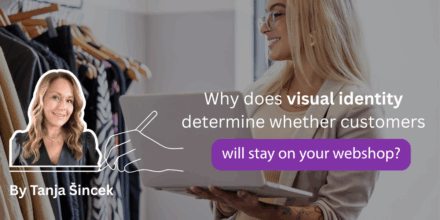Tanja Šincek is an eCommerce consultant and the founder of Webroom Agency, specializing in launching online businesses, developing eCommerce solutions, and optimizing sales. With over 300 completed webshop and digital projects, she has helped numerous brands build, grow, and scale their online presence. As a mentor and educator, she supports companies and entrepreneurs in growth through sales strategies, digital marketing, and AI tools.
—
As an eCommerce consultant who’s worked on over 300 webshops – from small local brands to large regional B2B enterprises – there’s one question I keep hearing:
“What do I need to know before starting a webshop and going into online business?”
Although every project is unique, some questions, challenges, and mistakes keep repeating. This article gives a realistic overview of what you should consider before diving into eCommerce.
Why start a webshop at all?
If you’re still weighing whether you need a webshop alongside your physical store, consider this:
- According to Eurostat, over 75% of consumers in the EU shop online regularly
- In Croatia, online shopping has grown by over 40% in the past three years – and the trend is still rising
- New generations (especially Gen Z and millennials) prefer online shopping – they want it fast, available 24/7, and without the need to visit a physical store
- Having a brick-and-mortar store is no longer enough – a webshop isn’t just an extra sales channel; it’s a tool for expanding your market, improving your positioning, and increasing sales
It allows you to be present where your customers are—on their phones, on the couch in the evening, while traveling, or researching before buying in-store.
Still wondering, “Is a webshop right for me?”
The answer is simple: If you sell products – then yes.
10 Key Things You Need to Know Before Launching a Webshop
1. You’re not just launching a webshop – you’re launching a digital business
An online store isn’t just a “digital shop window.” It must be integrated into your broader business strategy – logistics, marketing, customer support, and inventory management. If it doesn’t “breathe” in sync with the rest of your business, it quickly becomes a burden, not a solution.
2. A webshop is not a magic money-making box
Launching a webshop doesn’t guarantee automatic sales. It’s like opening a physical store – you need foot traffic, a solid offering, clear communication, a smooth buying experience, and trust. A webshop is just one tool in your business model; you need to know how to use it.
3. First – define what you’re selling and to whom, and analyze the competition
The most demanding clients want to “sell everything to everyone.“ Focus. Ask yourself:
Who is your customer? What’s their problem? How does your product solve it or bring joy?
Without a clear picture of your ideal buyer, all your marketing will fall flat—and so will your potential revenue.
Look at what others are doing: pricing, offer, design, support, content, payments, delivery.
Ask yourself: Where am I better? What makes me different? If you can’t answer that, stop and return to the basics.
4. Choose the right platform (and partners)
Not everyone needs Shopify or WooCommerce. And not everyone needs an agency. If you’re a small brand, start simple – but make sure your platform supports future growth.
I often advise starting with the basics, testing the market, and scaling when (and if) needed. Whether it’s a custom CMS, WooCommerce, Magento, or Wix, the choices are many, but not every tool fits every business.
If you’re unsure where to begin, consult someone with experience in different webshop setups. Platform choice will impact everything, from development costs and scalability to usability.
5. No strategy = no sales
Some believe that once the webshop goes live, sales will automatically follow. Sadly, that’s not how it works.
Who are your customers? How will you attract them? What makes you stand out?
How will you manage customer relationships, pricing, promotions, and content?
A webshop without a strategy is like a store without staff or a display window.
6. Start with basic functionalities
Don’t try to do everything at once. Your webshop doesn’t need a million features on day one.
What matters is that it’s fast, that products are well-presented, that prices are clear, that delivery terms are transparent, and that payment is smooth. Later, you can add advanced features like filtering, reviews, AI recommendations, etc.
I always advise my clients to build strong foundations first. Then, in Phase 2, let the webshop fund its upgrades.
7. Your photos and product descriptions make the sale
Invest in quality visuals and clear descriptions. Bad photos, generic copy, and a non-existent blog are a recipe for digital failure.
Online shoppers can’t touch the product – so what you write and show drives their decision.
And yes, your phone is not a professional photo studio – sometimes, it pays to invest in professional images.
8. Marketing starts before launch
Even during development, you should know: How will you bring in your first visitors? Where will you find them? What’s your cost per click? Who’s managing your social media? Will you have a newsletter?
Without a promotion plan, your webshop is like a stunning, stunning store at the top of a mountain, but no one knows it exists.
9. Measure everything from day one
Connect your webshop to Google Analytics, use tools like Hotjar or Clarity to analyze user behavior, and track sales KPIs and reports.
These aren’t just boring numbers – they show you what’s working and what’s not.
Use that data to adjust your offer, pricing, delivery, UX, and more.
10. Simplify checkout and follow payment trends
Shoppers hate complicated checkouts. Make payments fast, ensure your mobile version is lightning-quick, and ensure that delivery/return information is clear and transparent.
Even small functionality gaps – like not offering card payments – can cost you sales.
Modern buyers expect wallets, Google Pay, and Apple Pay to be seamless and mobile-friendly.
Monri offers exactly these solutions – fast, secure, mobile-optimized payments that customers now expect as standard.
The biggest shock?
When a client spends everything on building the webshop and has no budget left for marketing.
Remember – no one will buy from you if no one sees you. That’s why I always say:
Don’t forget your marketing budget.
Final thought – a webshop isn’t a “project”; it’s a process
Launching a web shop can be one of the best moves for your business – if approached strategically.
From my experience on 300+ eCommerce projects, I can say one thing:
When done right, your webshop becomes your strongest sales channel.
When done hastily, it often becomes the costliest mistake.
So plan, educate yourself, surround yourself with the right partners – and then go for it.
And you know what? There’s no better time than now.
In the next blog, I’ll cover how to choose the right platform and what to consider before development begins.
Learn more about Monri Online Payments.



